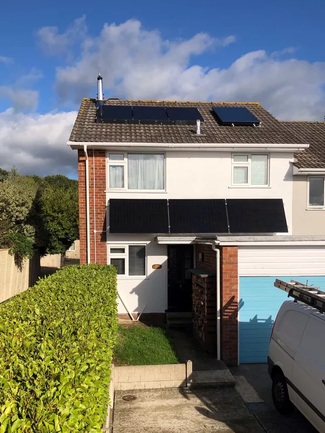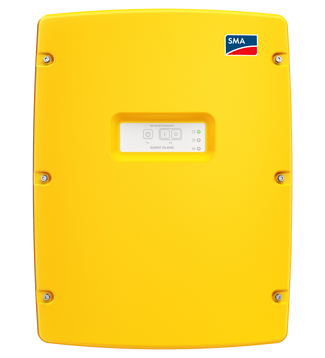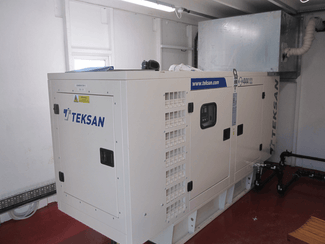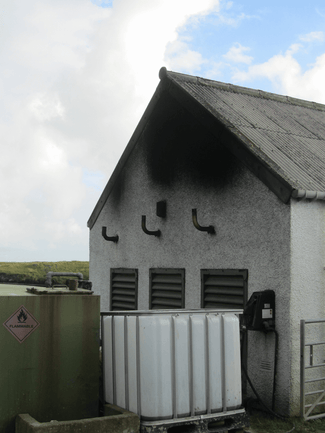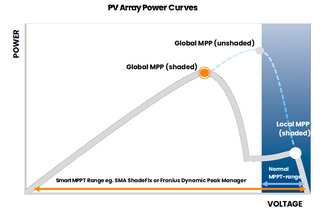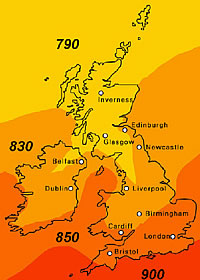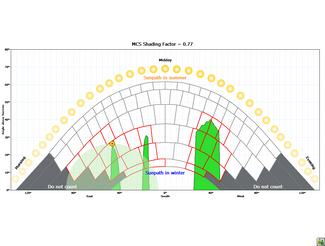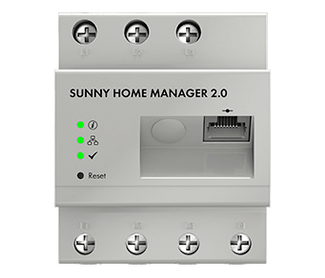Assess Your Requirements
When planning for an off grid renewable energy system it is vital to assess your specific requirements . ie. what appliances - lighting, heating, cooking, refrigeration, pumping etc - you want to power from the installation.
The power requirement of these functions must be determined, as well as their frequency of use (and in some circumstances the likely timing of their use, so that the peak requirement at any one time is known).
Conservation of energy usage may be feasible in some situations, through for example changing appliances or adjusting one's lifestyle.
See also: Ways to Save Electricity
After determining these requirements, and having decided which sources of renewable energy are most suited to the location, it is necessary to carefully match the individual parts of the system - batteries, inverters, generators etc.
This process enables one to make the most efficient use of the energy available, and to have energy available at the time(s) it is needed.
System Sizing
The precise balance and size of the components of a wind/solar system depends upon your location and anticipated power requirements, both 230V AC 'mains' and low voltage DC. A wide range of high efficiency appliances, batteries, controllers and inverters are available to meet most needs.
The number of consecutive days without sun or wind, together with patterns of use and peak power demand, determine both the battery store size and inverter or back-up generator requirement. Seasonal as well as daily variations are important.
If preferred a flexible approach can be adopted with components added in order of priority and a system expanded by the addition of additional battery store or generating capacity as needs change or finance allows.
A useful tool for estimating monthly output using sunlight data for anywhere in Europe and Africa is available here.
Power Requirements in a battery based system
Both existing and/or anticipated power requirements must be ascertained as a first step in sizing a system.
Factors to consider include:
- Variety of loads to be run: e.g.. domestic lighting, refrigeration, pumps, etc.
- Peak Consumption: total loads that might be required to be run at any one time
- Average Consumption: typical loads that need to be run most of the time
- Minimum/Continuous Consumption: any loads that need to be run all the time
- Voltage and frequency: of required loads, DC or AC
- Pattern of usage: daily, weekly, and seasonal
- Degree of automation required: whether supply needs to have 100% availability
In designing a power supply it is important to consider the whole home as a system; loads are interrelated, eg. correctly placed windows can help with heating and lighting; insulation reduces heating requirements etc.
Energy conservation plays an important role in keeping the costs of any energy supply down.
The use of energy efficient appliances and lighting, use of non-electric alternatives wherever possible, and increased awareness of patterns of use, all contribute towards the success and potential for a renewable energy system.
Cooking and Heating
Conventional electric cooking, space heating and water heating use a prohibitive amount of electricity. Electric cookers use about 1500 watts per ring, so bottled gas and solid fuel stoves are usually used for cooking. If electric cookers are used then induction hobs are the most efficient.
A microwave oven has a large power draw, but since food is cooked much more quickly, the total power consumption may not be too large.
Good passive solar design and proper insulation can reduce the need for heat, further space heating can be provided by propane or solid fuel. This is also used for water heating and can be combined with solar water heating systems.
In the larger wind turbine systems excess power will be available at times which can be used in immersion heaters, space heaters and storage heaters. This tends to coincide with colder windy weather but it's usefulness depends upon system sizing, so some supplementary heat source will still be necessary.
Refrigeration
Electric fridge and freezers should be of high efficiency types and the higher cost of modern efficient refrigeration will be more than made up by savings in other system costs. Gas powered fridges are a good alternative in small systems if bottled gas is available.
Lighting
In a small home, vehicle, caravan or boat, the best choice for lighting is usually to run lighting on low voltage DC directly from the battery.
Wiring runs can be kept short so relatively small gauge wire can be used, an inverter is not required so system cost is lower, and if high efficiency DC LED lights are used then high levels of lighting can be obtained from even small systems.
In larger installations, or ones with existing wiring, or where combined with a diesel generator, use of an inverter to supply AC power for LED lighting is recommended.
Appliances
Small Appliances
Electronic equipment, such as audio visual equipment and computers etc. have a low power consumption. Often these are available in low voltage DC as well as conventional AC versions, and usually the DC models use less power than their AC counterparts.
Many other small appliances such as toasters, kettles, irons and hair dryers consume large amounts of power but require very short or infrequent use periods.
This means that if the system inverter, battery and charging system are large enough they may be usable.
Major Appliances
Most large electrical appliances are usually only available in AC versions, -vacuum cleaners, pumps, power tools, fans, etc. These require a suitably sized inverter.
Washing machines are usually the largest electrical load in a typical domestic situation. However, since they are run for fixed periods it is usually better to use a standby generator for such loads and at the same time use any spare capacity for battery charging.
Water Pumping
This needs to be considered carefully. In sunny climates direct solar pumping may be advantageous.
See: Solar Pumping
Wind & Solar Sizing
This is decided so that the battery store can be maintained from available local renewable resources of wind/solar/& water or even via a backup generator. Wind generator &/or PV output characteristics, together with averages and patterns of windspeed or sunlight hours, must be considered in choosing the generating equipment. Wind and solar resources are often complimentary (high winds & low sun in winter and vice versa) so combining both can result in a smaller battery store and a overall cheaper and more efficient system.
See: Wind Power Basics
Location
The expected output from wind and PV generators depends very much on location, time of year and weather etc. In designing the optimum system it is important to have as much information as possible regarding local climatic conditions.
For example:
- Site description
- Including position of proposed wind/solar generators relative to loads, location of any nearby buildings, trees or hills etc., soil conditions, access conditions, space for batteries etc.
- Local wind conditions
- average wind speed, prevailing directions, seasonal variations and periods of calm
- Solar conditions
- whether there is any shading
- average daily hours of sunshine, summer & winter.
- Other weather conditions such as average rainfall, frequency of fog, snow and lightning etc.; average, maximum & minimum temperatures.
See: Siting Solar Systems and Wind Power Siting and Planning
Sizing the Battery
This depends on the power requirements and also on the required period of available storage -determined by climate and seasonal weather patterns; availability of standby power (or not); and not least budget!
For a small system three days storage might be sufficient. For a remote telecommunications site maybe several weeks.
The amount of electricity stored in a battery is measured in amp hours. This storage should be sufficient to last several days without any recharging -bearing in mind that for long life a battery should only be discharged to 20% capacity before recharging.
Normally three to four days storage will be sufficient, especially if a back-up supply e.g. generator is available.
Actual sizing is very difficult since the amount of wind or solar charging energy is highly dependent on the weather, consequently a system that incorporates both wind and solar inputs will require a considerably smaller battery than one with a sole power source.
Other factors such as criticality of the loads (resulting in a larger battery store for fail safe operation) and whether seasonal patterns of consumption match seasonal patterns of generation (allowing a smaller battery) are also important.
NB. Larger battery banks should consist of large 2 volt cells connected in series rather than lots of 12V batteries in parallel in order to avoid circulating currents within the battery and possible early battery failure.
Choosing the Battery Voltage
In small systems the most commonly used voltage is 12 Volts, for which a wide range of lights and appliances are available. If long cable runs are required or if an inverter of more than 1000 watts is needed then a 24 Volt system is advisable. In larger household systems 48 Volts is normally used and all loads are then inverter powered.
Sizing the Inverter
To size an inverter in addition to the average power consumption, peak power consumption needs to be considered. You will need to add up the consumption of all the appliances you may need to operate at once – that will represent your minimum inverter size. If your appliances include induction motors, like washers, dryers, dishwashers and large power tools, be sure to select an inverter with sufficient surge capability to accommodate the higher start-up loads.
This is estimated by adding the wattages of the largest number of devices that are likely to be operated at the same time. The continuous rating of the inverter should be greater than this figure.
Most inverters have an overload capability, for short periods, of two or more times their rated output, and this is needed for it to cope with the starting surges involved in electric motors -often three times their rated power. If several motors can start automatically (e.g. fridge and freezer) then it is possible for them to start simultaneously, so their combined starting surge must be taken account of. If a motor starts when an inverter is already heavily loaded this can overload the inverter giving a 'black out', so it is advisable to have any other motors (e.g. well pump) on manual control to reduce peak power consumption.
Most of the time an inverter will only be lightly loaded so it is important to choose one that is efficient at low load levels as well as at rated output.
Using a Generator
In order not to oversize the inverter (and so also save on battery and wind/solar costs) a back up generator can be incorporated and the use of the heaviest loads (e.g. washing machine, well pump etc.) restricted to when the generator is running. A battery charger can then also be run with any spare generating capacity.
The generator should be sized to cover the likely peak power consumption of all appliances, and the aim should be to run it for short periods at full capacity.
Such load management and proper timing of peak power consumption can lead to considerable cost benefits. If loads are spread out a smaller inverter can be utilised for vacuum cleaning when it's windy or pumping when sunny means power generated is being used directly - in times of little wind and sun, energy should be conserved.
Again, selection of efficient appliances can improve system efficiency.

